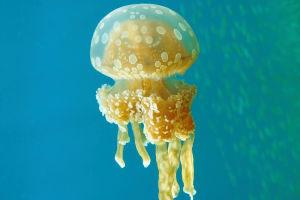The starfish, a seemingly simple marine creature, hides many astonishing secrets.
Though often regarded as the “decorations” of the deep sea, their biological characteristics are truly unique.
This article will take you on an exploration of the five major secrets of starfish, revealing how these fascinating creatures thrive in the vast ocean.
1. Regenerative Ability
One of the most remarkable abilities of starfish is their regenerative power. As members of the phylum Echinodermata, starfish can completely regenerate lost arms over time. This means that even if a starfish loses most of its body, it can still survive.
What's even more intriguing is that, in some cases, a detached arm can grow into a whole new starfish. This ability offers them a significant survival advantage when threatened by predators or injury. Scientists are studying the starfish’s regeneration mechanisms, hoping to one day apply this knowledge to the field of regenerative medicine, especially in humans.
2. No Brain but Sharp Senses
Although starfish do not have a brain, they possess a surprisingly sophisticated sensory system. They rely on eye spots located at the end of each arm to detect light and movement. These eye spots function as rudimentary visual organs, helping them navigate their surroundings.
While their vision is not as developed as mammals or other higher organisms, it enables them to find food and avoid predators. Additionally, the starfish’s nervous system is distributed throughout its body, functioning as a decentralized “neural network.” This network allows them to quickly respond to external stimuli and make effective reactions without the need for a central brain.
3. Extraordinary Geometric Structure
The starfish’s body features a striking pentaradial symmetry, a five-pointed structure that is not only aesthetically pleasing but also advantageous in the marine environment.
Their bodies typically consist of five arms radiating from a central disk, forming a perfect pentagon. This geometric form aids in their movement and allows them to extend their arms in all directions, maximizing their ability to sense the environment and capture prey.
4. Mystery of Movement
Unlike other marine creatures, starfish rely on a complex water vascular system, scientifically known as the "hydraulic system," to move. Without traditional muscles, starfish pump seawater into their bodies, using hydraulic pressure to move their tube feet, enabling them to slowly crawl along the seafloor.
This system also helps them capture food and even assists with respiration. This clever design allows starfish to maneuver flexibly in the challenging seabed environment and remain competitive in the battle for food.
5. External Digestion
Starfish have a unique way of feeding through "external digestion." Unlike most animals, a starfish can evert its stomach, extending it outside of its body to engulf and digest prey. Their diet primarily consists of mollusks like clams and mussels.
Using their powerful arms, they pry open the shells of their prey, then extend their stomach into the shell, secreting digestive enzymes that liquefy the soft tissues. The starfish then absorbs the digested nutrients. This method of external digestion allows them to consume larger prey and provides them with a significant predatory advantage.
Starfish, as extraordinary creatures of the sea, showcase the endless wisdom of nature through their unique structure and survival strategies. Their way of life and their crucial role in marine ecosystems remind us that the mysteries of the deep ocean are still far from fully understood.


